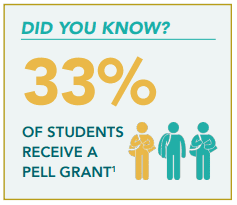101: Pell Grant Rainy Day Fund
What is the Pell Grant Program?
 The Pell Grant program is a federal means-tested program that offers postsecondary aid in the form of a grant to be used for tuition, fees, and related expenses. Operated by the U.S. Department of Education’s (ED) Office of Financial Student Aid (FSA), the Pell Grant program is available on a sliding scale to individuals based on financial need, cost of attendance and part- or full-time status.
The Pell Grant program is a federal means-tested program that offers postsecondary aid in the form of a grant to be used for tuition, fees, and related expenses. Operated by the U.S. Department of Education’s (ED) Office of Financial Student Aid (FSA), the Pell Grant program is available on a sliding scale to individuals based on financial need, cost of attendance and part- or full-time status.
Why the Pell Grant Matters
The finances of today’s students should not preclude anyone from accessing and obtaining a high-quality degree or credential. Research shows that individuals with postsecondary degrees or credentials earn significantly more over their lifetimes compared to their peers with only a high school diploma. The Pell Grant program is an evidence backed tool to help today’s students pay for higher education and earn meaningful degrees and other credentials.
Funding the Pell Grant program is a complex, sometimes confusing process. The Pell Grant funding mechanism can generate shortfalls and surpluses. In times of surplus, the Pell program gathers a “rainy day fund,” which can provide a cushion in case of future deficits or unexpected cost increases. This explainer resource from Higher Learning Advocates breaks down why leaving the surplus untouched is in the best interests of college affordability and the fiscally responsible thing to do.
